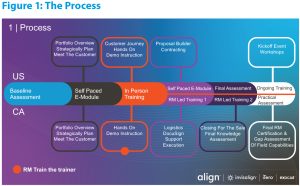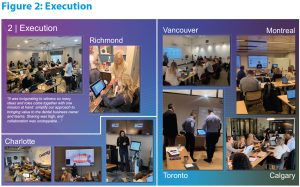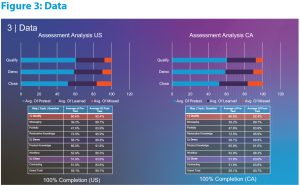
COVER STORY – By Brian Swaney
The best training programs start with a plan
The orthodontic industry is dynamic and constantly evolving, driven by technological advancements and a growing demand for innovative solutions. That means a successful go to-market launch takes more than cutting-edge technology. Investment in an effective sales training program as part of a go-to-market strategy can make a marked difference in awareness and adoption of the solution.
Training programs play a crucial role in equipping sales representatives with the knowledge and skills required to effectively market and sell their products. Enhancing the sales team’s product knowledge also boosts their confidence.
When a salesperson can easily articulate a product’s value proposition, they can engage in a deeper dialogue around opportunities as well as potential customer concerns, and they can do so consistently. Uniformity in messaging helps establish credibility, builds trust and creates a strong brand identity, ultimately leading to increased customer loyalty and higher sales.
The best training programs start with a plan and a smart, goal-oriented team. Together with the right stakeholders you can cover the fundamentals of the plan –objective of the training, time frame, necessary resources, anticipated business response and key performance indicators.
Best practices include the following five tips:
- Identify Key Learning Objectives
When designing an effective training plan, the sales training department should identify the specific learning objectives aligned with the product and its target market. This includes understanding product capabilities, features and the competitive landscape. - Product Knowledge Transfer
The success of any training program is best measured by its ability to transfer comprehensive product knowledge to the new sales team. It’s important to remember that a sales team is made up of individuals who process information in different ways.
A variety of formats and modalities can help ensure that the information is both received and understood by the intended audience. A combination of workshops, live demonstrations and hands-on training sessions can help familiarize sales representatives with a product’s features, functionality and real-time applications.
Encouraging interaction between experienced users and the sales team allows for firsthand insights and tips, fostering a deeper understanding of the product’s potential benefits. - Effective Sales Techniques and Communication Skills
Product knowledge provides the foundation that is followed by a rigorous review of effective sales techniques and communication skills. To be successful, sales representatives must have the ability to tailor their approach to specific customer needs and overcome objections.
Role-playing exercises and simulated customer scenarios provide sales representatives with an opportunity to refine their pitch and address common concerns encountered during the sales process. - Technical Proficiency and Customer Support
To ensure seamless integration of the product into dental practices, the sales team needs to have a solid foundation in technical aspects, including installation processes, troubleshooting techniques and software compatibility. Furthermore, comprehending the robust customer support infrastructure that accompanies the product ensures that sales representatives can appropriately address concerns and provide timely solutions to potential customers. - Ongoing Support and Evaluation
We view the training plan not as a one-time event, but rather an ongoing process that keeps sales representatives engaged and informed. Establishing a support system that includes regular training updates, podcasts, tutorials and access to comprehensive knowledge resources aids in addressing new challenges and advancing sales representatives’ expertise continually.
The Sales Training Program Process
We divided the learning into three distinct phases: qualifying and targeting the right customers, demonstrating the technology and closing the sale. We created two different learning pathways for the United States and Canada that would meet the learning objectives in each country respectively.
The training pathways ran simultaneously and featured multiple modalities to ensure we were following the 55-25-20 principle of adult learning. (Figure 1)
Our plan began with a robust baseline assessment to determine the knowledge of the team prior to the go-to-market shift. These pretest scores were also compared to post-assessment data to determine effectiveness of our learning journey.
Immediately upon completion of the baseline assessment, the learner was enrolled in the self-paced e-learning module, which was an interactive in-house built e-learning that reviewed the product portfolio, pre-call planning and how to deep-dive and discover during customer interactions to better understand the needs and goals of our customers.
Phase two included getting hands-on with the technology and learning how to conduct a product demonstration. The result was an extremely collaborative, highly impactful session that ensured sellers had the knowledge and skill to fully integrate this technology into their customers’ practices. (Figure 2)
The third and final phase featured a fully immersive and self-paced e-learning module that was centered around closing the sale. Because the knowledge and skill learning had already occurred, sales representatives could focus on best practice sharing and collaboration, which ultimately set them up for success to hit the ground running to start the year. (Figure 3)
Conclusion
A meticulously designed and comprehensive training plan can make all the difference when launching a new go-to-market strategy in any industry. By focusing on product knowledge transfer, effective sales techniques, technical proficiency and ongoing support, teams can be set up for success.
Empowering sales representatives with the necessary skills and knowledge to effectively communicate the benefits of the product fosters customer trust and confidence, ultimately leading to increased sales and market share.
Through continuous learning, evaluation and support, sales training departments can ensure that the sales teams remain at the forefront of the industry, ready to embrace new challenges and drive success in the dynamic world of dental sales.
 Brian Swaney is sales training manager for Align Technology. Email Brian at bswaney@aligntech.com or connect with him on LinkedIn at linkedin.com/in/brianmswaney.
Brian Swaney is sales training manager for Align Technology. Email Brian at bswaney@aligntech.com or connect with him on LinkedIn at linkedin.com/in/brianmswaney.












